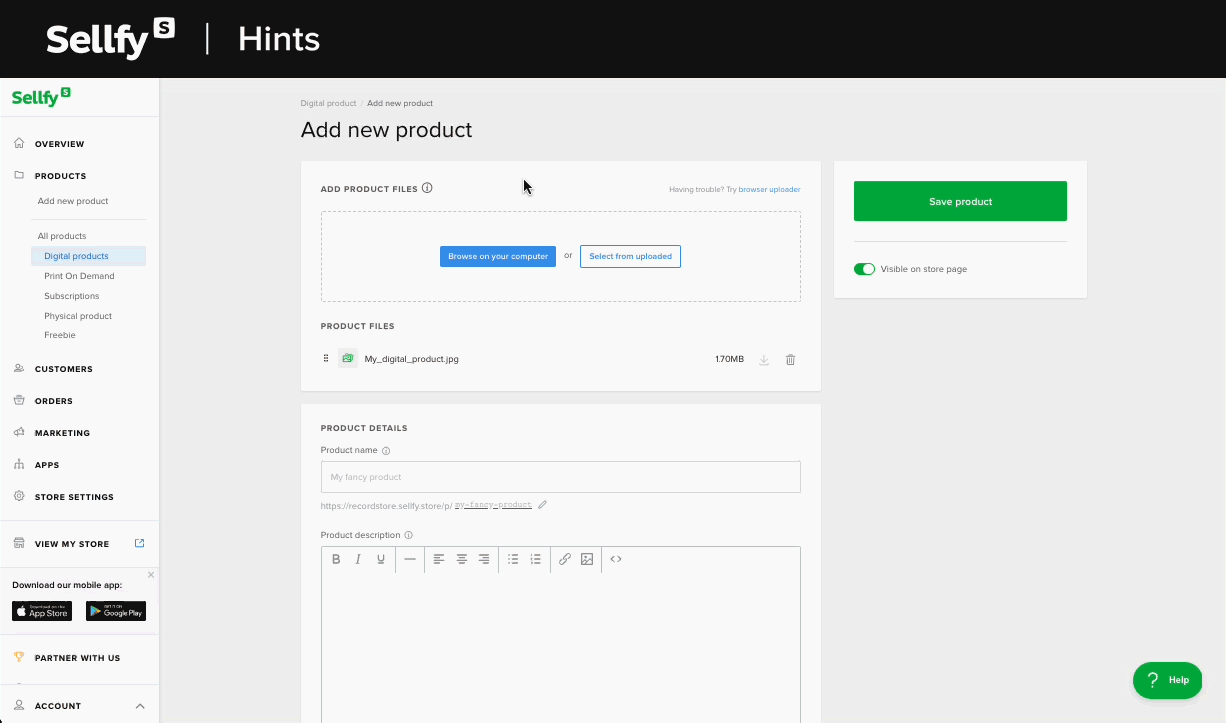Are you planning to sell digital products in 2025, but unsure which platform to choose? With so many options out there, it can be overwhelming.
But don’t worry! This article dives deep into the battle of Sellfy vs Shopify, helping you decide which is better for your needs. Each platform has its strengths and quirks, and the right choice could mean the difference between thriving sales and missed opportunities.
Imagine having a seamless experience where you can easily set up shop, reach your audience, and watch your sales grow. We’ll explore user-friendly interfaces, pricing plans, and features tailored for digital products. By the end of this read, you’ll feel confident in making an informed decision, tailored just for you. Stick around to discover which platform will elevate your digital sales game in 2025!
Platform Overview
Sellfy offers simplicity for digital sellers. It supports instant delivery of files. Users find it easy to set up. Sellfy’s pricing is straightforward. No hidden fees. Sellfy has customizable storefronts. You can change colors and layout. It includes built-in marketing tools. These tools help increase sales. Sellfy provides analytics to track performance. You can see your sales data. Reports are easy to understand.
Shopify is a popular platform for selling. It offers a wide range of features. Users can sell physical and digital products. Shopify has many themes for customizing stores. Users can make their store unique. The platform offers advanced analytics. These help in understanding customer behavior. Shopify supports various payment options. Customers can pay easily. The platform has integrations with many apps. This expands functionality.
Ease Of Use
Sellfy is simple to use. No coding skills needed. Set up a store in minutes. The dashboard is clear and easy. Upload digital products fast. Choose a template and customize it. Sellfy helps with marketing tools.
Customers have a smooth checkout. Payments are secure. Everything is built-in. No need for extra apps. It’s a great choice for beginners.
Shopify is popular but more complex. It offers many features. Setup can take longer. Beginners might need help. The dashboard has many options. Customization is flexible.
Shopify supports many apps. It helps with advanced marketing. The checkout process is smooth. Payments are secure. Overall, it suits larger stores well.
Customization Options
Sellfy offers simple design tools for beginners. Choose from pre-made templates. Customize colors and fonts easily. No coding needed. This makes it easy to start. Create a basic store look quickly. The design tools are user-friendly. Beginners can learn them fast. Limited options for advanced users. This can be a drawback. But beginners will find it helpful.
Shopify provides extensive design tools. Choose from a wide range of professional templates. More customization options are available. Advanced users can edit code. This allows for unique store designs. Many plugins enhance design features. This offers flexibility for all users. The learning curve might be steeper. But the results are rewarding. Shopify is great for creative freedom.
Pricing Structures
Choosing between Sellfy and Shopify for selling digital products depends on your needs. Sellfy offers straightforward pricing, ideal for beginners. Shopify provides more features but can be pricier. Consider your budget and business goals for 2025.
Sellfy Pricing Plans
Sellfy offers three main pricing plans. The Starter plan costs $19 per month. The Business plan is priced at $49 monthly. The Premium plan costs $99 each month. All plans include unlimited products. Sellfy gives access to essential features like custom domain and discount codes. The higher plans have more advanced features. These include email marketing tools and product upselling options. Sellfy offers a 14-day free trial to test its service.
Shopify Pricing Plans
Shopify offers a wider range of pricing options. The Basic Shopify plan costs $29 monthly. The Shopify plan is $79 per month. The Advanced Shopify plan costs $299 each month. All plans allow you to sell unlimited products. Features include an online store and sales channels. Higher plans offer advanced reporting and shipping rates. Shopify provides a free trial for new users.
Payment Options
Sellfy provides simple payment integration for selling digital goods, while Shopify offers a range of payment gateways. Both platforms cater to different needs, making it essential to choose based on specific business requirements.
Sellfy Payment Gateways
Sellfy offers limited payment options. You can use PayPal and Stripe. Both are popular and trusted by many. PayPal is easy for buyers to use. Stripe is also simple and safe. Both gateways support credit card payments. Sellfy does not offer many other gateways. This can be a limitation for some sellers.
Shopify Payment Gateways
Shopify provides more choices. It supports over 100 payment gateways. This includes PayPal, Stripe, and many others. You can choose the best option for your store. Shopify Payments is their own system. It is easy to set up and use. It also allows credit card payments. Many sellers like the flexibility Shopify offers.

Credit: webdesksolution.com
Digital Goods Management
Sellfy makes selling digital products easy. You can upload files like e-books, music, or videos. It provides secure downloads for buyers. Sellfy handles file delivery smoothly. Sellers can track sales and earnings. You can set up discounts and offers. It’s user-friendly and simple to use. Sellfy offers limited customization options for product pages.
Shopify is popular for selling physical and digital goods. You can add digital files easily. It offers a wide range of tools. Shopify allows customizable product pages. It integrates with various apps. Sellers can provide automatic download links. Shopify’s platform is flexible. It requires additional plugins for some digital features.
Marketing Tools
Sellfy offers simple tools for marketing. Users can create discount codes for their products. Email marketing is easy with Sellfy. It helps to keep in touch with customers. Built-in social media integrations help to promote products. Users can track sales with analytics tools. Sellfy makes marketing easy for beginners. It’s perfect for small businesses. The platform has everything needed for digital sales.
Shopify provides strong marketing tools. Users can create discounts and special offers. Email campaigns are simple to set up. Shopify integrates with many social media platforms. Analytics tools help track marketing success. Shopify offers advanced marketing features. Suitable for large businesses and experts. It provides a wide range of options for digital sales.

Credit: sellfy.com
Customer Support
Sellfy provides a simple support system. Email support is available for all users. They also have an extensive help center. This includes guides and FAQs. Users find answers quickly. Live chat is not available. Response times may vary. Generally, they reply within 24 hours. Sellfy also offers a community forum. Users can share tips and help each other. This is useful for new sellers.
Shopify offers 24/7 support. Live chat, email, and phone are available. They have a large support team. This means faster response times. Shopify also has a vast help center. It includes articles and tutorials. Users can learn on their own. Their community forum is very active. Many users share their experiences. This helps new sellers greatly. Shopify’s support is more comprehensive.
Security And Reliability
Sellfy offers simple security features for digital products, while Shopify provides advanced options for reliable transactions. Both platforms ensure safe delivery, but Shopify’s extensive tools might appeal more to sellers needing comprehensive security measures. Choose based on your specific needs for protecting digital products in 2025.
Sellfy Security Measures
Sellfy protects your store with SSL encryption. This keeps data safe from hackers. It also uses secure payment gateways like PayPal and Stripe. These gateways ensure safe transactions. Sellfy regularly updates its platform. This helps prevent security breaches. Two-factor authentication is available for added protection. Sellfy stores data securely on trusted servers. Your digital products are safe from unauthorized access.
Shopify Security Measures
Shopify uses strong SSL certificates to protect data. It also offers PCI compliance. This ensures credit card info is safe. Shopify has a dedicated security team. They work to fix vulnerabilities quickly. Regular updates keep the platform secure. Shopify provides two-factor authentication for user accounts. Its servers are highly secure. Your store data is safe from threats.

Credit: www.learnworlds.com
Pros And Cons
Sellfy is easy to use. It is great for beginners. The setup is fast and simple. You can sell products quickly. Sellfy offers good pricing plans. These plans are affordable. But, it has limited design options. Some people want more choices. Another downside is fewer integrations. This might be a problem for some users.
Shopify is very popular. Many people trust it. It offers lots of themes. Users can customize their stores. Shopify has many apps. These apps add features. But, Shopify can be expensive. The monthly fees are higher. Also, the learning curve is steep. Beginners might need more time to learn.
Frequently Asked Questions
What Are Sellfy And Shopify’s Main Features?
Sellfy offers easy setup and digital product focus, while Shopify provides extensive customization and scalability for various product types. Both platforms support payment gateways and marketing tools, but Shopify has more advanced options. Choose Sellfy for simplicity or Shopify for comprehensive online store management.
Which Platform Is Cost-effective For Digital Products?
Sellfy generally offers lower pricing plans, ideal for small businesses selling digital products. Shopify’s pricing is higher but includes advanced features suitable for large-scale operations. Evaluate your budget and business needs to decide which platform provides the best value for your digital product sales.
Can Sellfy Handle Large Product Volumes?
Sellfy is designed for simplicity and ease of use, primarily targeting small to medium-sized businesses. It may not be ideal for handling large product volumes or complex catalogs. Shopify, with its robust infrastructure, is better suited for businesses with extensive product ranges and higher sales volumes.
Does Shopify Support Digital Product Sales?
Yes, Shopify supports digital product sales alongside physical products. It offers extensive features for managing digital downloads and provides tools for marketing, payment processing, and customer management. Shopify’s scalability makes it a strong choice for businesses aiming to expand their digital product offerings.
Conclusion
Choosing between Sellfy and Shopify depends on your needs. Sellfy offers simplicity for digital sales. Shopify provides flexibility with more features. Think about your business size and goals. Sellfy suits small creators well. Shopify works for those who need a bigger store.
Consider your budget too. Sellfy has lower upfront costs. Shopify might require more investment. Both platforms are reliable for selling digital products. Compare features and decide what’s best for you. Remember, your choice should align with your business vision. Make informed decisions for success in 2025.


